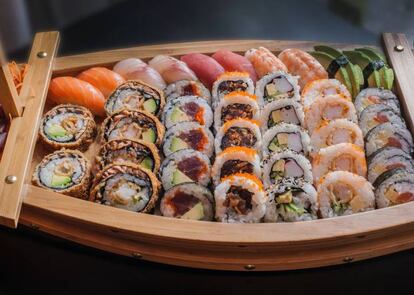Mango sushi, QR codes and other things that should be off the restaurant menu
The modern restaurant experience has been adversely affected by the pandemic and some misguided attempts toward the avant-garde

Restaurants, like spas and the Satisfyer, were designed for pleasure. Everything about them is designed so that the customer can focus exclusively on enjoying the food: you’re not expected to set the table, waiters attend to your every need, someone else does the cooking and you don’t have to wash up afterward. But in an increasing number of restaurants there are also aspects that make the experience less satisfactory. Nothing in this world is perfect, after all.
EL Comidista consulted several critics to find out what makes them knock a few stars off an establishment. These are not necessarily culinary: there are those who would prefer never to see another gyoza and others who have had quite enough of the QR code.
Fantasy sushi
Food critic and television presenter Mikel López Iturriaga has a mission: a personal crusade against the “stuff with rice” that some sushi has been transformed into. “In the tackiest places, makis and nigiris have become debauched with ingredients as absurd as they are overelaborate: mango, papaya, caramelized pear, cheese, crispy onion, glazed foie, roast beef… preferably all battered, fried and with a couple of kilos of spicy mayonnaise on top.” For Iturriaga, it is an exercise in “more is better that would send any venerable sushi chef in Tokyo to his grave with a heart attack, but in now practiced with abandon is supposedly trendy restaurants.”
The non-cooking kitchen
It seems like a contradiction, but gastronomic journalist David Remartínez points to the number of restaurants that do not cook their own food. “Unfortunately, there are a proliferation of these restaurants, which don’t deserve to be called as such half their menus, or more, is fifth-rate: ‘home-made’ croquettes that have been bought, artichokes that they have not preserved, lamb ingots that arrive in bricks for their microwave… and so on and so on. It’s legitimate to serve these kinds of products but be honest and specify that the dish has not been cooked by you, but by a company you trust, as you would do if you served me something out of a tin.”

Gyozas
Like the Almighty, gyozas are everywhere. Not just in modern places kitted out entirely by IKEA, but also in those that used to serve traditional fare. And if their ubiquity is already irritating, what makes it worse is that they are often nothing more than a fried dumpling made by a contracted company (apparently the only one in Europe, because they all taste the same). Lord, please find it in your mercy to put an end to this, as you once did with baked provolone and balsamic cream.
Being rushed out of the door
In restaurants, as in any business, the higher the turnover, the fatter the bottom line. That’s why it’s understandable that they try and move the old timer who orders a coffee and a glass of tap water along before he settles in for a fortnight. But there are also places where you’ve barely opened the menu and they’re already taking your order. Eleven seconds later the waiter brings what he ordered for you and three minutes after that you’re being asked what you want for dessert. Before you’ve had a chance to say you’re not big on sweet things, the check arrives with the card machine.
Waiters who laugh at dietary requirements beyond their own
“There are people who think Twitter is their workplace and that they can spout whatever imbecilities occur to them there, and that gate with a steep path down to idiocy opens wide at the exact moment that the words “vegan” or “vegetarian” are uttered,” says Mònica Escudero, food critic and editor of El Comidista, who adds this incomprehension is often accompanied by unsolicited observations as: “Ah, but steak is so good, you don’t know what you’re missing,” and “vegetarianism is for rabbits.” And, says Escudero, who isn’t vegan, you have to “muster all the good manners that they lack not give them your opinion of their opinions.”

QR codes and infinite menus
María Borrás, executive director of the production company Unto, would like to see QR codes, which became ubiquitous during the pandemic, abolished in its aftermath. “I can’t stand those codes anymore. They are practical, but I like restaurant menus, specials boards, touching the paper, calmly looking to see what’s on offer.” But although Borrás likes menus, she is not a fan of those that have “an infinite number of options.”
A number of restaurants will offer brunches and dinners without a cooker, oven, lighting or coffee machine; the initiative will last four days. https://t.co/32zfPbkAIk
— The Brussels Times (@BrusselsTimes) September 27, 2022
‘Soft’ lighting
Patricia Tablado, social media manager for El Comidista, points to restaurants with funereal lighting as a bugbear. “I don’t know if it’s just a Madrid thing, but all of the new places that open up favor those languid bulbs that give off exactly enough light so that you don’t bump into the furniture when you go to the bathroom. I want to see what I’m eating and the people I’m eating with, because sometimes you don’t know if you’re at a restaurant or a séance.”
‘Creative’ bathroom door indications
Sonia Cerezal, video editor at Unto, has a deep dislike of a modern trend that seems to have spread like soft butter on warm bread. “I can’t stand it when they get creative with the doors to the ladies’ and gents’ bathrooms. They expect you to figure out if you identify more with an orchid or a banana tree.”
Tu suscripción se está usando en otro dispositivo
¿Quieres añadir otro usuario a tu suscripción?
Si continúas leyendo en este dispositivo, no se podrá leer en el otro.
FlechaTu suscripción se está usando en otro dispositivo y solo puedes acceder a EL PAÍS desde un dispositivo a la vez.
Si quieres compartir tu cuenta, cambia tu suscripción a la modalidad Premium, así podrás añadir otro usuario. Cada uno accederá con su propia cuenta de email, lo que os permitirá personalizar vuestra experiencia en EL PAÍS.
¿Tienes una suscripción de empresa? Accede aquí para contratar más cuentas.
En el caso de no saber quién está usando tu cuenta, te recomendamos cambiar tu contraseña aquí.
Si decides continuar compartiendo tu cuenta, este mensaje se mostrará en tu dispositivo y en el de la otra persona que está usando tu cuenta de forma indefinida, afectando a tu experiencia de lectura. Puedes consultar aquí los términos y condiciones de la suscripción digital.
More information
Últimas noticias
Most viewed
- Reinhard Genzel, Nobel laureate in physics: ‘One-minute videos will never give you the truth’
- Oona Chaplin: ‘I told James Cameron that I was living in a treehouse and starting a permaculture project with a friend’
- Pablo Escobar’s hippos: A serious environmental problem, 40 years on
- Why we lost the habit of sleeping in two segments and how that changed our sense of time
- Chevy Chase, the beloved comedian who was a monster off camera: ‘Not everyone hated him, just the people who’ve worked with him’











































